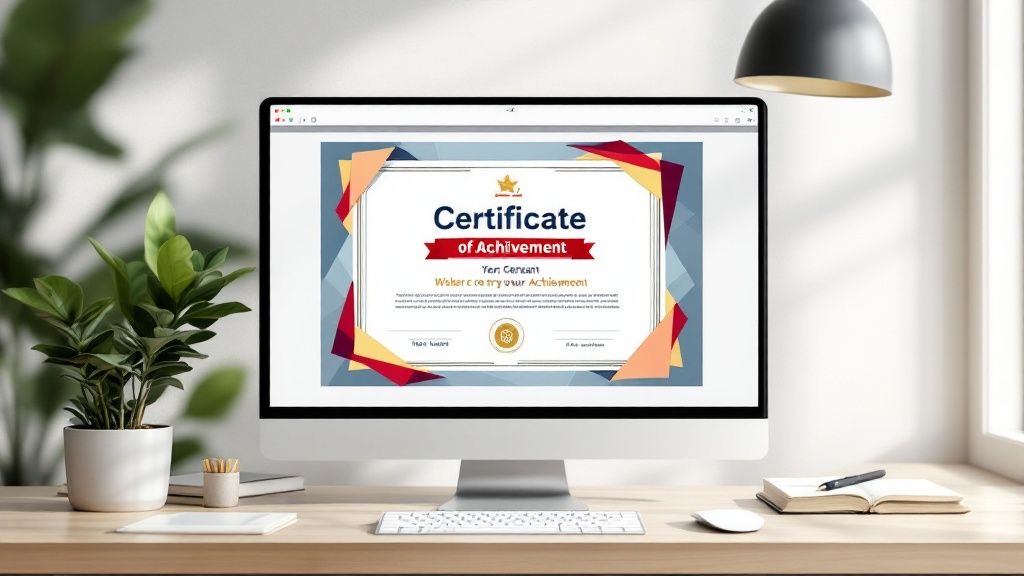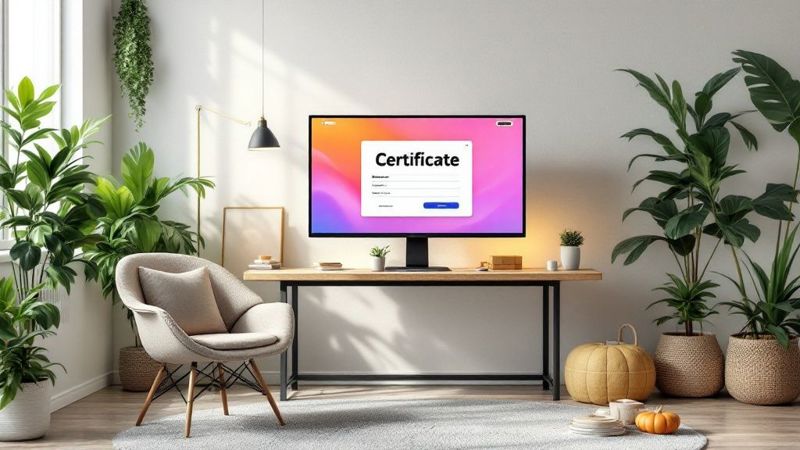Moving to Digital Certificates: A Modern Solution

Organizations are shifting away from paper certificates to digital solutions. This change helps businesses and institutions work more efficiently while maintaining trust and security. Many are discovering the benefits of platforms that let them create certificates online at no cost.
Key Advantages of Digital Certificates
Digital certificates excel in several important ways compared to paper versions. They're simple to store and retrieve, greatly reducing risks of loss or damage. The ability to verify authenticity helps combat credential fraud. Digital formats also cut down on administrative work, saving organizations valuable resources.
Making Certificate Creation Simple Through Automation
Automation is where digital certificates really shine. Modern platforms let you create hundreds of personalized certificates in minutes. You can pull data directly from spreadsheets and learning systems to automatically fill certificate templates. This removes manual data entry and prevents mistakes. Certifier, a leading certificate platform, serves over 1,800 major organizations. Users can generate, distribute and monitor certificates in large batches. By connecting data from Excel, Google Sheets, Zoom, Microsoft Teams, and learning platforms like Teachable, organizations save up to 6 hours weekly on certificate management.
Getting Started with Digital Certificates
While switching to digital certificates may seem challenging at first, many platforms make it straightforward. Their user-friendly tools require minimal technical knowledge. Most offer free trials or basic plans so organizations can test the system before upgrading. This makes it easy to try creating certificates online without risk. With some planning and the right platform, the transition to digital certificates can be smooth and beneficial. Digital systems help organizations issue professional, secure credentials that properly honor achievements.
Mastering Free Certificate Platforms: A Strategic Approach

Creating professional certificates doesn't have to break the bank. Free online certificate tools give you the ability to recognize achievements and milestones without spending money. The key is picking the right platform that matches your needs.
Key Features to Consider
When choosing a free certificate platform, focus on what matters most for your specific use case. The interface should be simple enough that anyone can use it without technical expertise. You'll want access to plenty of pre-made templates that work for different types of certificates. If you need to create certificates in bulk, look for automation features.
Key things to evaluate:
- Clean, straightforward interface that's easy to navigate
- Good selection of certificate templates and designs
- Batch creation tools for making multiple certificates
- Options to add your logo and brand elements
- Flexible delivery methods (email, download, etc.)
Comparing Popular Platforms
Each free certificate platform has its own pros and cons. Here's how some of the main options stack up:
| Feature | Platform A | Platform B | Platform C |
|---|---|---|---|
| User Interface | Simple | Advanced | Intermediate |
| Template Library | Basic | Extensive | Moderate |
| Automation | Limited | Robust | Basic |
| Branding | Basic options | Full control | Limited options |
Want more tips on creating personalized certificates? Check out our guide on How to master personalized certificates.
Maximizing Free Tier Benefits
Free versions have some limitations compared to paid plans, but you can still create great-looking certificates by working within those constraints. Common restrictions include monthly certificate limits or fewer template choices. Focus on nailing the essential design elements that matter most for your certificates. With smart planning and the right platform choice, you can produce professional results without spending any money.
Creating Certificates That Command Attention and Respect

A great certificate does more than document an achievement - it makes the recipient feel proud and motivated. The design choices you make directly impact how people perceive and value the certificate. Let's explore how to create certificates that recipients will want to display prominently.
The Psychology of Effective Certificate Design
What makes certain certificates catch your eye and leave a lasting impression? Most often, it's a perfect blend of professional polish and visual appeal. A messy or confusing layout can make even significant achievements seem less meaningful. The key is creating a clear visual structure that guides the viewer's attention.
Mastering Visual Hierarchy and Typography
The best certificates use visual hierarchy to naturally direct focus to the most important elements. Here's how to achieve this:
- Size and Scale: Make the recipient's name and achievement stand out as the largest text elements
- Color and Contrast: Use color purposefully to highlight key information
- Whitespace: Leave plenty of breathing room between elements for a clean, refined look
Font choice matters too. Pick fonts that look professional while being easy to read. A classic combination is using a serif font for the main text with a sans-serif font for headings to create visual interest.
Branding and Customization: Making it Your Own
Adding your organization's branding helps create polished, consistent certificates. Tools like Visme make this easy with customizable templates. Used by over 34,300,000 people across 133 countries, Visme lets you incorporate your logos, colors, and fonts to maintain brand identity across all certificates.
Practical Workflows for Brand Consistency
To keep your certificates looking uniform, create clear guidelines for:
- Approved fonts and colors
- Logo placement and sizing
- Overall layout structure
This ensures quality and professionalism whether you're creating completion certificates, awards, or other recognition documents. Following these design principles helps you produce certificates that both look great and carry real meaning for recipients.
Making the Most of Certificates in Education

Schools, universities and training programs are finding new ways to use certificates to improve student success. When implemented thoughtfully, certificates can motivate students and validate their hard work. A well-designed certificate program adds real value to courses and training.
How Certificates Drive Student Success
Getting a certificate after completing challenging coursework gives students a concrete symbol of their achievement. This recognition builds confidence and encourages them to keep learning, especially in online courses where personal interaction may be limited. The visible proof of accomplishment helps maintain student engagement over time. You might be interested in: How to master B2B email marketing personalization.
Building Effective Certificate Programs
The best certificate programs do more than just mark completion - they verify specific skills and knowledge that matter in the real world. For example, a project management certificate should focus on essential abilities needed on the job. Certificates work best when they fit into a larger learning path, marking key milestones while encouraging ongoing growth. Digital certificates have made this type of recognition more accessible. Platforms like Cursa now offer free online courses with digital certificates. With 6.5 million students and 48,000 free exercises, Cursa helps people develop valuable skills. These certificates strengthen resumes and career opportunities. Find more details here.
Making Certificates Count
For certificates to have real value, they must be credible. Schools need solid ways to verify that certificate holders truly gained the promised skills. This often involves thorough testing, hands-on projects, or peer evaluation. Aligning certificates with industry standards also helps - it shows employers that the skills are relevant and up-to-date. When done right, certificates become valuable proof of professional abilities.
Implementing Robust Certificate Management Systems
Creating an effective system to manage certificates is essential for any organization issuing credentials. A well-designed system ensures authenticity and makes distribution smooth for both issuers and recipients.
Automating Certificate Generation and Distribution
Manual certificate creation becomes challenging as programs grow. Setting up automated workflows saves time and reduces errors. Modern platforms offer features like:
- Bulk generation from spreadsheet data
- Integration with learning management systems
- Direct email delivery to recipients
- Connection with tools like Zapier for automated workflows
Maintaining Security and Preventing Fraud
Security should be a top priority when issuing certificates online. Key security features include:
- Digital signatures on each certificate
- Unique identification numbers
- Secure storage of recipient data
- Regular system audits
- Access controls for system users
Strategic Approaches to Digital Delivery and Accessibility
Make certificates easily accessible to recipients by:
- Offering multiple download formats (PDF, JPG, PNG)
- Providing secure cloud storage options
- Creating clear access instructions
- Enabling easy certificate retrieval
- Supporting different device types
Think of it like a digital library - recipients should be able to access their credentials whenever needed, in their preferred format.
Scaling Challenges and Security Considerations
As your certificate program grows, prepare for:
- Increased storage requirements
- Higher volume of requests
- More complex access management
- Additional security needs
Choose a platform that can handle growth smoothly. Role-based access control becomes important for larger teams, letting you assign specific permissions to different users while maintaining security. Regular reviews of system performance and security help ensure everything runs efficiently, even with thousands of certificates.
Consider implementing a tiered storage system - keeping frequently accessed certificates readily available while archiving older ones. This approach, similar to how libraries manage physical and digital collections, helps balance accessibility with resource usage.
Overcoming Technical Hurdles and Optimization Strategies
Creating free certificates online is convenient but can present some challenges. Here's a guide to common technical issues and practical solutions to maintain quality certificate production.
Common Technical Issues and Solutions
Certificate generation sometimes hits unexpected roadblocks. A frequent issue is data mismatch - when spreadsheet data doesn't align with certificate template fields, often due to different column headers. The fix? Carefully check your data against template requirements before uploading.
Template compatibility can also cause problems. Each platform accepts different file types and sizes, so a template that works on one system might fail on another. Always test your template with your chosen platform first. You might find helpful: How to master dynamic email images in your marketing strategy.
Making Your Process More Efficient
A smooth certificate generation process starts with good organization. Create clear guidelines for every step - from picking templates to entering data and checking quality. Think of it like setting up a production line for your certificates.
Quality checks are essential. Set up a review process to catch errors before sending certificates. Even a quick visual check can prevent embarrassing mistakes. Small investments in quality control pay off in maintaining your professional reputation.
Keeping Certificates Secure and Authentic
Trust is the foundation of any certificate's value. Consider adding security features like unique IDs and digital signatures to protect against fraud. These simple additions help ensure your certificates are seen as legitimate documents.
Practical Steps for Success
Use these checklists to keep your process running smoothly:
- Data Check: Verify all recipient information
- Template Test: Confirm template works on your platform
- Design Review: Check branding and overall look
- Test Run: Send yourself a sample before mass distribution
Set up verification steps, like checking certificate IDs against your records, to confirm authenticity when needed.
Good certificate generation combines technical accuracy with quality control. By planning ahead and following consistent procedures, you'll create certificates that are both efficient to produce and trustworthy.
Want to simplify your certificate creation? Try OKZest to automate your process with dynamic image generation.